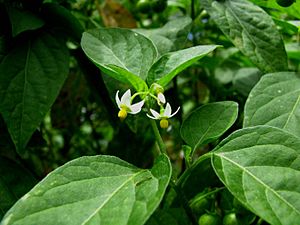American black nightshade facts for kids
Quick facts for kids American black nightshade |
|
|---|---|
 |
|
| Scientific classification | |
| Genus: |
Solanum
|
| Species: |
americanum
|
| Synonyms | |
|
|
Solanum americanum, also called American black nightshade or glossy nightshade, is a type of flowering plant. It grows like a herb and can be found in many parts of the world.
This plant is naturally found in warm areas like the Americas, Melanesia, New Guinea, and Australia. It has also spread to other tropical places. This includes islands in the Pacific and Indian Oceans, like Hawaiʻi, and parts of Africa. People might have helped it spread to these new areas.
Solanum americanum is part of a larger group of plants. It can sometimes look very similar to other "black nightshade" plants. One example is the European nightshade, Solanum nigrum.
Contents
What Does Solanum americanum Look Like?
This plant can grow up to 1 to 1.5 meters (about 3 to 5 feet) tall. It can live for just one year or for a few years. Its leaves grow on opposite sides of the stem. They can be quite big, up to 10 cm (4 inches) long and 7 cm (3 inches) wide. The edges of the leaves can be wavy or have small teeth.
The flowers are small, about 1 cm (0.4 inches) across. They are usually white, but sometimes they can be light purple. They have yellow parts in the middle called stamens. After the flowers, the plant grows shiny black berries. These berries are small, about 5 to 10 mm (0.2 to 0.4 inches) wide. Each berry contains many tiny seeds.
How Scientists Classify Solanum americanum
Scientists who study plants are called botanists. They group plants based on how they are related. This is called taxonomy. Solanum americanum can look different depending on where it grows. Because of this, some botanists think it might actually be more than one species. Others believe it's just one species with different types, called subspecies.
Some botanists also think that Solanum americanum might be the same species as the European nightshade, Solanum nigrum. They are very similar!
Is Solanum americanum Safe?
It is very important to know that Solanum americanum contains chemicals that can be poisonous. These chemicals are called glycoalkaloids. Because of these, people should be very careful if they use this plant for medicine or food.
The green, unripe berries are especially dangerous. Eating them has caused serious harm to children. Even ripe berries and the leaves can be harmful. The plant's poisonous nature seems to get a little weaker as the berries ripen.
The amount of poison in the plant can change a lot. It depends on the plant's genes and where it grows. Things like the soil and how much rain it gets can affect it. Experts who study poisonous plants give this important advice: "Unless you are absolutely sure that the berries are from a type that is safe to eat, do not touch them." It is always best to avoid eating any wild plants unless an adult who knows them well says they are safe. This plant can also be harmful to farm animals if they eat too much of its leaves.
Images for kids
See also
 In Spanish: Solanum americanum para niños
In Spanish: Solanum americanum para niños


